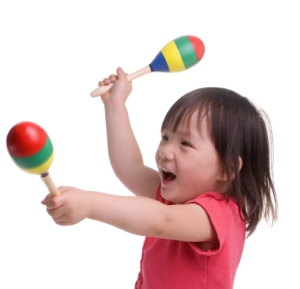 There’s a reason you find rattles in almost every culture around the globe.
There’s a reason you find rattles in almost every culture around the globe.
They are amazingly simple and very powerful at the same time. A child playing a rattle becomes aware of how his or her movements change the sound they are making. They realize how the sound they create can “fit” with a beat and most studies of young children show that they are keenly aware of rhythmic patterns. Making and playing several varieties of homemade rattles can be a great way to explore music and have fun with a young child at the same time.
Recycled Rattles for Home or Classroom Play
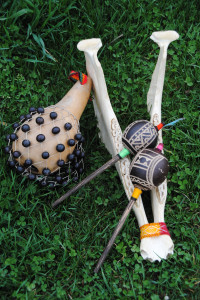
Rattles made from gourds, seeds, feathers and a donkey’s jawbone
Most early rattles were made of materials such as dried gourds, seashells, clay, coconuts, bark and a variety of other natural objects. In Africa, caxixi rattles are made from woven fiber. In India, special rattles are made from colorful palm fronds woven together in clever patterns. On the coast of Peru there’s even a rattle made from the jawbone of a donkey. In short, people make instruments from materials that they have found available near their home. We are going to take that same approach to creating recycled rattles!
Clean and dry a variety of small plastic containers (water bottles, juice containers, etc.) and assemble some objects that can serve as the contents of the rattles. Here’s a list of common materials that work well and the type of sound they create:
 Quiet rattles: sand, salt, sugar, confetti, cotton balls, craft puff balls, paper bits, Q-tips, tiny pasta (such as pastina or acine de pepe).
Quiet rattles: sand, salt, sugar, confetti, cotton balls, craft puff balls, paper bits, Q-tips, tiny pasta (such as pastina or acine de pepe).
Medium Rattles: paper clips, small pebbles, birdseed, small beads, small dried beans, rice, smaller buttons.
Loud Rattles: dried macaroni/pasta, large pebbles, large beads, coins, large dried beans, larger buttons.
The Inside of the Rattle
Choose the objects you’d like to add to the rattle to create the sound and also consider including some decorative elements. Since plastic containers are transparent, you can easily add confetti, glitter, colorful ribbon, pipe-cleaners or similar items. They won’t alter the sound but they will add color, beauty and interest when the rattle is being played.
 The Outside of the Rattle
The Outside of the Rattle
If you like, you can decorate the outside of the rattle with stickers, markers or add a handle made from pipe-cleaner, yarn or ribbon. Feel free to get creative. When you’re done, it’s time to seal it with some sturdy tape, such as electrical tape. This helps keep the contents inside and generally makes it more child-safe around young music-makers.
Now you’re ready to have fun with your rattle!
Time To Play!
 Shake along while you sing one of your favorite songs. Try playing slowly and shaking your rattle to the beat. Then speed up the song. Can you keep up and keep in time? Play along with recorded music. Listen to different types of music and see how your rattle fits in with the music being played.
Shake along while you sing one of your favorite songs. Try playing slowly and shaking your rattle to the beat. Then speed up the song. Can you keep up and keep in time? Play along with recorded music. Listen to different types of music and see how your rattle fits in with the music being played.
An Easy Rattle Game For Young Children
If everyone in a class or a small group has made a rattle, you try this easy game.
Ask the children to play a certain way until the music stops. For instance, the teacher can say: “Shake your rattle softly until the music stops”. The teacher stops the recorded music (like in a game of musical chairs) at an unexpected place and sees if all the students were able to stop at the same time. Next, change the directions to other simple ways to play, such as:
Shake your rattle back and forth until the music stops.
Shake your rattle up and down until the music stops.
Shake your rattle round and round until the music stops.
Shake your rattle very softly until the music stops.
Shake your rattle loudly until the music stops.
Shake your rattle down low until the music stops.
Shake your rattle up high until the music stops.
Shake your rattle quickly until the music stops.
Shake your rattle slowly until the music stops.
Aside from this one game, there are lots of other ways you can make music and have fun with a rattle while you are learning, playing and recycling – all at the same time!
Here Are Some Variations On Rattle Crafts:
Monster Rattles – From Egg Cartons
https://www.teacherspayteachers.com/Product/HALLOWEEN-MUSICAL-RATTLE-BASED-ON-PERUVIAN-QUIJADA-1146672
Make Your Own African Coffee Can Drum – https://www.teacherspayteachers.com/Product/Make-Your-Own-African-Drum-Craft-3507618
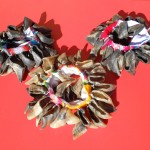 Make Your Own Maracas – https://www.teacherspayteachers.com/Product/Latin-American-Intruments-Make-Your-Own-Maracas-142802
Make Your Own Maracas – https://www.teacherspayteachers.com/Product/Latin-American-Intruments-Make-Your-Own-Maracas-142802
MYO Chapchas- Goat Toe-Nail Rattlers from South America – https://www.teacherspayteachers.com/Product/Chapchas-A-Unique-Rattle-From-Latin-America-1426778
 Next choose a long, thin piece of grass, and stretch it between your thumbs, making it as tight as you can. The grass should look as if it is dividing the space between your thumbs.
Next choose a long, thin piece of grass, and stretch it between your thumbs, making it as tight as you can. The grass should look as if it is dividing the space between your thumbs.









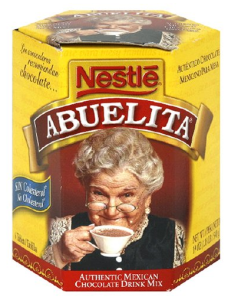
 Almost every parent has had the experience of giving their child a special present and finding that they were more excited about playing with the box. So, why fight it? With the holidays bringing so many different size and shape packages to your doorstep, it’s a great time to have a little musical fun by creating instruments called rattle boxes. If you add textured fabric or paper as you decorate them, it becomes a musical and sensory experience as well!
Almost every parent has had the experience of giving their child a special present and finding that they were more excited about playing with the box. So, why fight it? With the holidays bringing so many different size and shape packages to your doorstep, it’s a great time to have a little musical fun by creating instruments called rattle boxes. If you add textured fabric or paper as you decorate them, it becomes a musical and sensory experience as well! Make Your Box Rattle!
Make Your Box Rattle!  Shake, Rattle and Roll Away!
Shake, Rattle and Roll Away! Have you ever seen Spanish castanets? Traditional ones are beautifully crafted or carved from wood and often painted with themes like the Spanish countryside or elegant dancers. Playing the castanets is a fun way of allowing a child to develop a sense of rhythm, fine motor skills and also a great way to explore the music and culture of Spain.
Have you ever seen Spanish castanets? Traditional ones are beautifully crafted or carved from wood and often painted with themes like the Spanish countryside or elegant dancers. Playing the castanets is a fun way of allowing a child to develop a sense of rhythm, fine motor skills and also a great way to explore the music and culture of Spain.
 This craft is so easy that even an adult can do it! Feel free to learn and play along with your child. Simply put the button castanets between your thumb and first finger and click away. Play fast, slow, or tap back and forth between the left hand and right hand. Click or clack along to a favorite song or rhyme or put on a recording of music that you love. See if you can match the beat you hear or create a new one that works with the song.
This craft is so easy that even an adult can do it! Feel free to learn and play along with your child. Simply put the button castanets between your thumb and first finger and click away. Play fast, slow, or tap back and forth between the left hand and right hand. Click or clack along to a favorite song or rhyme or put on a recording of music that you love. See if you can match the beat you hear or create a new one that works with the song.
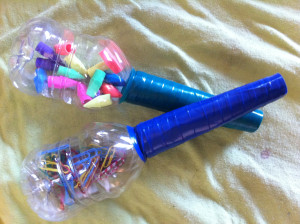
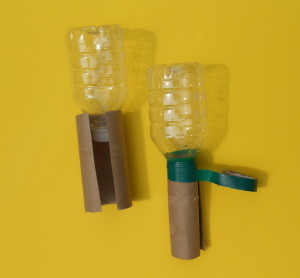
 This week we wanted to share a guest post and a wonderfully simple musical craft and activity from Cari at Time For Play – Button Gloves!
This week we wanted to share a guest post and a wonderfully simple musical craft and activity from Cari at Time For Play – Button Gloves!





 A
A 